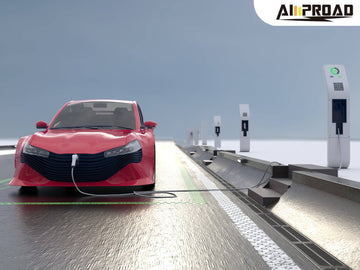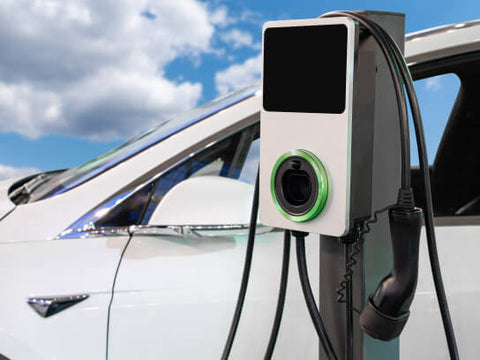
In the world of electric vehicles (EVs), the quest for optimal charging practices is paramount for preserving battery health and maximizing longevity. One common recommendation among EV enthusiasts is to charge the vehicle only to 80% capacity. But why? What benefits does this practice offer, and how can EV owners implement it effectively? In this article, we'll explore the importance of charging EVs to 80%, exploring the role of Level 2 EV chargers, portable chargers, and Tesla destination chargers in achieving optimal charging. By understanding the significance of this practice and adopting informed charging habits, EV owners can ensure not only the longevity of their vehicle's battery but also contribute to sustainable EV ownership.
The Significance of Optimal EV Charging
Charging your electric vehicle (EV) to only 80% capacity might seem counterintuitive at first glance, but it's a practice recommended by many experts in the field. Let's delve into why this approach is crucial for maximizing the lifespan of your EV's battery and ensuring optimal performance.
Why is it important to charge an EV to only 80%?
Charging your EV to only 80% capacity offers several key benefits that contribute to the long-term health of the battery. Firstly, it reduces stress on the battery cells, mitigating the risk of degradation over time. By avoiding a full charge, you can minimize the likelihood of overcharging, which can lead to excessive heat buildup and accelerated wear on the battery components.
How does a Level 2 EV charger facilitate optimal charging?
Level 2 EV chargers play a vital role in facilitating optimal charging practices for EV owners. These chargers offer higher power outputs compared to standard Level 1 chargers, allowing for faster and more efficient charging sessions. Additionally, Level 2 charging often come equipped with advanced features such as adjustable charging rates and smart charging capabilities, giving users greater control over their charging experience.
What features of Level 2 chargers support optimal charging?
Level 2 chargers boast several features that support optimal charging practices. These chargers typically operate at higher voltages and amperages, enabling faster charging while minimizing heat generation. Additionally, many Level 2 chargers offer programmable charging schedules and energy management features, allowing users to customize their charging sessions to align with off-peak electricity rates or other preferences.
How does the charging speed of Level 2 chargers impact optimal charging practices?
The charging speed of Level 2 chargers has a direct impact on optimal charging practices for EV owners. With faster charging rates, users can replenish their EV's battery more quickly, reducing downtime and enhancing convenience. However, it's essential to strike a balance between charging speed and battery longevity, as excessively fast charging can increase stress on the battery cells and compromise long-term durability.
By leveraging the capabilities of Level 2 EV charger and adopting informed charging habits, EV owners can optimize their charging experience and prolong the lifespan of their vehicle's battery, ultimately maximizing the value and performance of their electric vehicles.
The Role of Portable EV Chargers in Achieving Optimal Charging
Portable EV chargers play a crucial role in enabling EV owners to achieve optimal charging practices, offering flexibility and convenience for charging on the go.
How do portable EV chargers contribute to optimal charging practices?
Portable EV chargers offer a convenient solution for charging EVs to 80% capacity, aligning with optimal charging recommendations. These chargers are designed to be compact and lightweight, allowing users to carry them easily in the trunk of their vehicle or store them at home for emergency charging needs.
Portable EV charger is capable of charging EVs to 80% capacity, making them a practical choice for achieving optimal charging practices. While portable chargers may not offer the same charging speed as fixed Level 2 chargers, they provide sufficient power to replenish the battery to a desirable level for daily use.
Portable chargers offer several advantages in achieving optimal charging practices. Firstly, they provide EV owners with the flexibility to charge their vehicles wherever there is access to a power outlet, eliminating the need to rely solely on fixed charging infrastructure. Additionally, portable chargers are versatile and can be used in various locations, including home, work, or public charging stations, ensuring that EV owners have a reliable charging solution wherever they go.
How does the fastest home EV charger support optimal charging habits?
The fastest home EV chargers are designed to support optimal charging habits by offering high power outputs and advanced charging features. These chargers are capable of delivering fast and efficient charging, allowing EV owners to replenish their vehicle's battery quickly and effectively.
The fastest home EV charger typically features high amperage and voltage ratings, enabling them to deliver faster charging speeds compared to standard Level 2 chargers. Additionally, these chargers may come equipped with smart charging capabilities, allowing users to schedule charging sessions and monitor energy usage remotely.
The fastest home EV chargers align with optimal charging recommendations by offering fast and efficient charging while minimizing stress on the battery. By charging EVs to 80% capacity in a timely manner, these chargers help to prolong battery life and ensure reliable performance over time.
Exploring Tesla Destination Chargers and Their Role in Optimal Charging
Tesla destination chargers have become increasingly prevalent in the EV charging landscape, but how do they fare when it comes to optimal charging practices?
Are Tesla destination chargers conducive to optimal charging practices?
Tesla destination chargers are designed to provide convenient and reliable charging options for Tesla owners, but how do they stack up against other charging options in terms of optimal charging practices?
Compared to other charging options, such as public Level 2 chargers or DC fast chargers, Tesla destination chargers offer several advantages. They are often located at hotels, restaurants, and other destinations, making them convenient for travelers and those on long journeys. Additionally, Tesla destination chargers typically provide slower charging speeds compared to DC fast chargers but are faster than standard Level 2 chargers, allowing for efficient charging sessions.
While Tesla destination charger may not always offer the fastest charging speeds, they can still effectively facilitate charging EVs to 80% capacity. For many EV owners, charging to 80% is sufficient for daily driving needs and helps prolong the lifespan of the battery. Tesla destination chargers provide a convenient option for topping up the battery while out and about, ensuring EV owners can continue their journey with peace of mind.
How can EV owners integrate Tesla destination chargers into their charging routine?
Integrating Tesla destination chargers into your charging routine requires some consideration. It's essential to plan your route and identify locations with Tesla destination chargers along the way. Additionally, be mindful of charging etiquette and avoid monopolizing charging stations for extended periods to allow other EV owners to access them.
When utilizing Tesla destination chargers, EV owners should consider factors such as charging availability, charging speed, and charging costs. Some Tesla destination chargers may require payment or reservations, so it's essential to be prepared and plan ahead.
Tesla destination chargers play a vital role in expanding the EV charging infrastructure and making electric vehicle ownership more accessible and convenient. By providing charging options at popular destinations, Tesla destination chargers contribute to the overall growth and sustainability of the EV charging ecosystem, encouraging more drivers to make the switch to electric vehicles.
Maximizing Battery Health Through Informed Charging Practices
As electric vehicle (EV) ownership continues to rise, ensuring the longevity and health of EV batteries is paramount. Let's explore some additional tips for preserving battery health during charging and how optimal charging practices align with sustainable EV ownership.
What are some additional tips for preserving battery health during charging?
In addition to charging to 80% capacity, EV owners can take several steps to preserve battery health. Regularly updating software and firmware can optimize charging algorithms and battery management systems. It's also crucial to avoid exposing the battery to extreme temperatures, as excessive heat or cold can degrade battery performance over time.
Monitoring battery health is essential for maintaining optimal performance. Many EVs come equipped with onboard diagnostics systems that provide insights into battery health and charging patterns. Additionally, there are several third-party apps and devices available that allow EV owners to monitor battery status, charging history, and performance metrics in real-time.
Certain charging habits can accelerate battery degradation and shorten its lifespan. Avoid frequently charging the battery to 100% capacity, as this can increase stress on the battery cells and lead to premature wear. Additionally, rapid charging, especially at high temperatures, can degrade the battery faster than slower charging sessions.
How do optimal charging practices align with sustainable EV ownership?
Optimal charging practices play a crucial role in sustainable EV ownership by maximizing the lifespan of the battery and minimizing environmental impact. By charging to 80% capacity and avoiding excessive charging, EV owners can reduce the need for frequent battery replacements, which in turn reduces the carbon footprint associated with battery production and disposal.
Optimal charging practices help reduce environmental impact by extending the lifespan of EV batteries and minimizing the resources required for battery production. By prolonging battery life, EV owners can reduce the frequency of battery replacements, which in turn reduces the demand for raw materials and energy-intensive manufacturing processes associated with battery production.
Informed charging habits, such as charging to 80% capacity and avoiding rapid charging, contribute to the longevity of EVs and their batteries. By adopting these practices, EV owners can maximize the lifespan of their batteries, reducing the need for costly replacements and minimizing the environmental impact of EV ownership. Additionally, informed charging habits ensure that EVs remain reliable and efficient transportation options for years to come.




